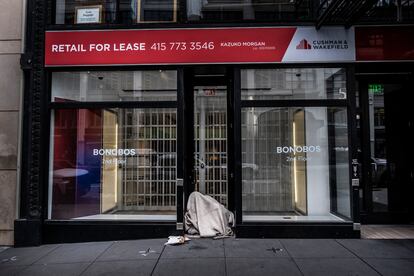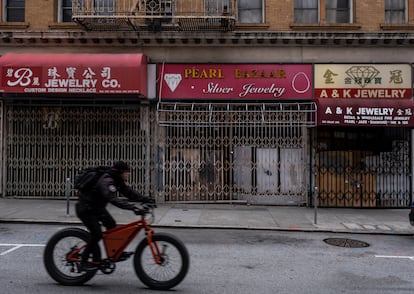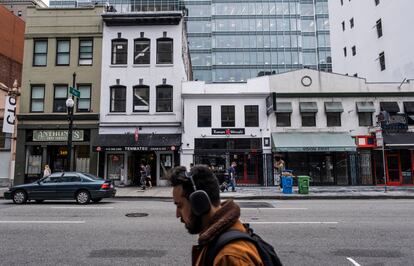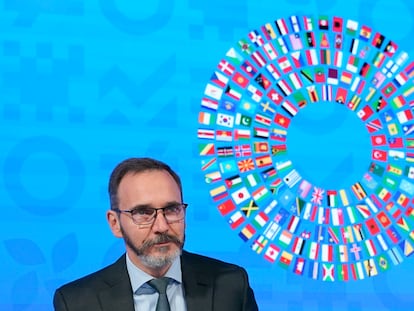The slow death of downtown San Francisco
The closure of retail businesses, increases in property crime and tech industry layoffs have all deepened the exodus from once-vibrant neighborhoods


The Salesforce Tower dominates the San Francisco skyline. Nearly 1,000 feet tall, it claims a prominent position in the center of the city. But the imposing missile-shaped building — which is lit up at the top — has a problem: it’s practically empty.
The business management company — the main employer in this city of tech companies — has struggled to get its 12,000 employees back to the office. After having decreed the death of working hours from nine to five back in 2021, Salesforce has subsequently backtracked on its hybrid model, which combined telework and in-person duties. This month, the firm promised to donate $10 to charity for every worker who physically comes to the tower, which is located between Mission Street and First Avenue. Since February, Salesforce has managed to get about 40% of its workforce back to the office.
Just a few blocks away, on Second Avenue, are the ruins of the Alexander bookstore. This past April, the independent bookseller celebrated 32 years since it opened its doors in one of the most touristy areas of San Francisco, just a few steps from the Embarcadero — the eastern waterfront of the city’s port. Today, the bookstore sports a large orange sign with the word “closed” written on it.
“We’re sorry to have to close and leave San Francisco with one less bookstore, especially in this neighborhood,” says a note taped to the door, meant for any person who didn’t hear about the massive going-out-of-business sale, which saw three floors of books — 50,000 titles — sold at a 25% discount.
The space to the left of the bookstore advertises that it’s for rent and has kitchen equipment — it’s waiting for someone to dare to put up a restaurant in an area that was vibrant just a few years ago. History repeats itself with the building on the right, a former bank branch. Jones Lang LaSalle — a local real estate agency — announces that it has nearly 11,000 square feet of space for rent. These types of posters can be seen in dozens of buildings for several blocks around.
The area is no longer good for business. Mike Stuppin — one of the bookstore’s owners — says that these blocks have lost half of their foot traffic in recent years.
“It’s been quite a challenge to place these properties since the pandemic, due to the increase in telecommuting, and also due to some problems that San Francisco has had in recent years,” says real estate broker Ben Lazzarechi in an email. He has several properties for rent in this zone.
A report from the end of June by a real estate consultancy estimated that a third of San Francisco’s downtown offices were empty by the end of the second quarter of 2023. “This percentage has grown over three years,” says Max Sander, another industry analyst. He mentions that the unoccupied buildings could open up a $200 million shortfall in the city’s budget by 2028 if the current trend continues. Some members of the City Council have compared this to the sighting of an iceberg on the horizon — one that could cause a catastrophe in the city’s finances.
It’s hard to count how many people downtown San Francisco has lost. Before the Covid-19 pandemic broke out, the authorities estimated that some 245,000 people worked there. Last February, a report commissioned by the City Council noted that at least 147,000 people had stopped going to the area, due to the change in dynamics caused by the health emergency. Some have returned, but the figure doesn’t contemplate another crisis: the economic one. Dozens of tech companies have cut back their payrolls since last year. According to the Layoffs.fyi website, dozens of companies — including Amazon, Meta, Google and Salesforce — have laid off some 200,000 employees so far in 2023 (although not all the positions were based in the city).

The agony of downtown San Francisco is especially noticeable in the retail sector. The crisis worsened in mid-June. Westfield — one of the most important shopping centers in San Francisco — recently announced that, after 20 years in operation near Union Square, it will be closing down. This is one of the obligatory stops for tourists visiting the San Francisco Bay Area. The company has defaulted on the $558 million loan for the property, which has more than 1.5 million square feet of shops and offices. Westfield has announced that it is seeking to transfer ownership of the business to another company… but so far, nobody is interested.
As justification for the closure, Westfield has cited the “difficult operating conditions of the downtown,” which have resulted in a steep drop in sales (partly due to the increase in online purchases), pedestrian traffic and tenancies. The Nordstrom department store — which occupied 20% of the space — has reported that it will not renew its lease and will close its doors after 35 years in business.
A cycle of ruin
While Westfield’s communications don’t specify the adverse conditions that the shopping center is facing, they’re well-known. In fact, locals refer to these conditions as the “doom loop,” in which one problem triggers another, causing a cycle of ruin. Among these is the crisis caused by a population of almost 8,000 homeless people in the city, which has about 800,000 inhabitants in total. These individuals are concentrated in the Tenderloin neighborhood, located in the heart of the city. The abuse of narcotics — which can be observed in broad daylight — the mental health crisis affecting many people, as well as the increase in juvenile delinquency are all factors that have caused difficulties for businesses. Merchants in downtown San Francisco have been facing an increase in the theft of merchandise and vehicles that is far higher than the national average. Homicides and other violent crimes, on the other hand, are below average.
This situation has been used as a “trump” card in the 2024 presidential election campaign. Ron DeSantis — the governor of Florida, who is trying to wrest the Republican nomination from Donald Trump — filmed a campaign ad at the end of June… in San Francisco. “We’re here in the once a great city of San Francisco. [But] we came in and saw people defecating in the streets. We saw people using heroin. We saw people smoking crack cocaine,” the politician says in the clip. He has cemented his strategy in a battle against the progressive policies that California has championed for decades.
Although DeSantis is committed to a radical right-wing discourse, the electorate in San Francisco seems to partly agree with his criticism of left-wing politicians. In a referendum that was held in June 2022, voters recalled the city’s district attorney from office, considering him to be too progressive. Sixty percent of voters opted to fire Chesa Boudin, in a rejection of some of the policies that he implemented, such as not requesting jail time for minor crimes as a way to combat prison overcrowding. This year, the former prosecutor — the son of two radical left-wing militants — signed on as the director of the Criminal Law & Justice Center at the University of California, Berkeley.

Boudin’s dismissal sent a signal to politicians in the Democratic stronghold. Since then, Mayor London Breed has opted for a more moderate image. Back in May, she announced that California state police would join patrols through the troubled Tenderloin streets, to apprehend heroin and fentanyl dealers. Fentanyl — an opioid — has sparked a national epidemic. In just one month since the start of the latest operation, the state police have collaborated with local authorities on 115 arrests, seizing 17 pounds of drugs.
Authorities have avoided revealing the exact number of officers who have taken to the streets. This past Thursday, however, Democratic Governor Gavin Newsom — a former mayor of San Francisco who maintains a political rivalry with DeSantis — announced that he will double the number of agents to continue to “fight crime and tackle the fentanyl crisis that has taken hold in the city.” His administration has invested $1 billion into reducing the impact of opioids in California, the most-populous state in the U.S., with over 39 million residents.
Whether these efforts can inject oxygen into the agonizing heart of San Francisco remains to be seen. At a forum hosted by Bloomberg in late-June, Mayor Breed asked to stop lamenting business closures. “It’s time to start reimagining what downtown can be,” she told the audience.
Sign up for our weekly newsletter to get more English-language news coverage from EL PAÍS USA Edition
Tu suscripción se está usando en otro dispositivo
¿Quieres añadir otro usuario a tu suscripción?
Si continúas leyendo en este dispositivo, no se podrá leer en el otro.
FlechaTu suscripción se está usando en otro dispositivo y solo puedes acceder a EL PAÍS desde un dispositivo a la vez.
Si quieres compartir tu cuenta, cambia tu suscripción a la modalidad Premium, así podrás añadir otro usuario. Cada uno accederá con su propia cuenta de email, lo que os permitirá personalizar vuestra experiencia en EL PAÍS.
¿Tienes una suscripción de empresa? Accede aquí para contratar más cuentas.
En el caso de no saber quién está usando tu cuenta, te recomendamos cambiar tu contraseña aquí.
Si decides continuar compartiendo tu cuenta, este mensaje se mostrará en tu dispositivo y en el de la otra persona que está usando tu cuenta de forma indefinida, afectando a tu experiencia de lectura. Puedes consultar aquí los términos y condiciones de la suscripción digital.
More information
Archived In
Últimas noticias
Welcome to the post-religion era: The idea of Christianity as the absolute truth has become obsolete
‘I thought you would like it’: The risky sexual practice popularized by TV shows and TikTok
The digitalization of tourism: ‘They promise experiences and gave us the worst possible one’
Mexican peso defies uncertainty with forecasts of a new period of stability in 2026
Most viewed
- Sinaloa Cartel war is taking its toll on Los Chapitos
- Reinhard Genzel, Nobel laureate in physics: ‘One-minute videos will never give you the truth’
- Oona Chaplin: ‘I told James Cameron that I was living in a treehouse and starting a permaculture project with a friend’
- Why the price of coffee has skyrocketed: from Brazilian plantations to specialty coffee houses
- Silver prices are going crazy: This is what’s fueling the rally









































